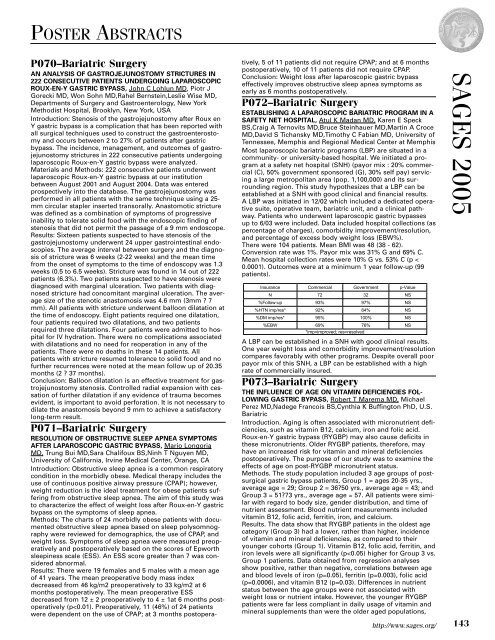2005 SAGES Abstracts
2005 SAGES Abstracts
2005 SAGES Abstracts
Create successful ePaper yourself
Turn your PDF publications into a flip-book with our unique Google optimized e-Paper software.
POSTER ABSTRACTS<br />
P070–Bariatric Surgery<br />
AN ANALYSIS OF GASTROJEJUNOSTOMY STRICTURES IN<br />
222 CONSECUTIVE PATIENTS UNDERGOING LAPAROSCOPIC<br />
ROUX-EN-Y GASTRIC BYPASS, John C Lohlun MD, Piotr J<br />
Gorecki MD, Won Sohn MD,Rahel Bernstein,Leslie Wise MD,<br />
Departments of Surgery and Gastroenterology, New York<br />
Methodist Hospital, Brooklyn, New York, USA<br />
Introduction: Stenosis of the gastrojejunostomy after Roux en<br />
Y gastric bypass is a complication that has been reported with<br />
all surgical techniques used to construct the gastroenterostomy<br />
and occurs between 2 to 27% of patients after gastric<br />
bypass. The incidence, management, and outcomes of gastrojejunostomy<br />
strictures in 222 consecutive patients undergoing<br />
laparoscopic Roux-en-Y gastric bypass were analyzed.<br />
Materials and Methods: 222 consecutive patients underwent<br />
laparoscopic Roux-en-Y gastric bypass at our institution<br />
between August 2001 and August 2004. Data was entered<br />
prospectively into the database. The gastrojejunostomy was<br />
performed in all patients with the same technique using a 25-<br />
mm circular stapler inserted transorally. Anastomotic stricture<br />
was defined as a combination of symptoms of progressive<br />
inability to tolerate solid food with the endoscopic finding of<br />
stenosis that did not permit the passage of a 9 mm endoscope.<br />
Results: Sixteen patients suspected to have stenosis of the<br />
gastrojejunostomy underwent 24 upper gastrointestinal endoscopies.<br />
The average interval between surgery and the diagnosis<br />
of stricture was 6 weeks (2-22 weeks) and the mean time<br />
from the onset of symptoms to the time of endoscopy was 1.3<br />
weeks (0.5 to 6.5 weeks). Stricture was found in 14 out of 222<br />
patients (6.3%). Two patients suspected to have stenosis were<br />
diagnosed with marginal ulceration. Two patients with diagnosed<br />
stricture had concomitant marginal ulceration. The average<br />
size of the stenotic anastomosis was 4.6 mm (3mm ? 7<br />
mm). All patients with stricture underwent balloon dilatation at<br />
the time of endoscopy. Eight patients required one dilatation,<br />
four patients required two dilatations, and two patients<br />
required three dilatations. Four patients were admitted to hospital<br />
for IV hydration. There were no complications associated<br />
with dilatations and no need for reoperation in any of the<br />
patients. There were no deaths in these 14 patients. All<br />
patients with stricture resumed tolerance to solid food and no<br />
further recurrences were noted at the mean follow up of 20.35<br />
months (2 ? 37 months).<br />
Conclusion: Balloon dilatation is an effective treatment for gastrojejunostomy<br />
stenosis. Controlled radial expansion with cessation<br />
of further dilatation if any evidence of trauma becomes<br />
evident, is important to avoid perforation. It is not necessary to<br />
dilate the anastomosis beyond 9 mm to achieve a satisfactory<br />
long-term result.<br />
P071–Bariatric Surgery<br />
RESOLUTION OF OBSTRUCTIVE SLEEP APNEA SYMPTOMS<br />
AFTER LAPAROSCOPIC GASTRIC BYPASS, Mario Longoria<br />
MD, Trung Bui MD,Sara Chalifoux BS,Ninh T Nguyen MD,<br />
University of California, Irvine Medical Center, Orange, CA<br />
Introduction: Obstructive sleep apnea is a common respiratory<br />
condition in the morbidly obese. Medical therapy includes the<br />
use of continuous positive airway pressure (CPAP); however,<br />
weight reduction is the ideal treatment for obese patients suffering<br />
from obstructive sleep apnea. The aim of this study was<br />
to characterize the effect of weight loss after Roux-en-Y gastric<br />
bypass on the symptoms of sleep apnea.<br />
Methods: The charts of 24 morbidly obese patients with documented<br />
obstructive sleep apnea based on sleep polysomnography<br />
were reviewed for demographics, the use of CPAP, and<br />
weight loss. Symptoms of sleep apnea were measured preoperatively<br />
and postoperatively based on the scores of Epworth<br />
sleepiness scale (ESS). An ESS score greater than 7 was considered<br />
abnormal.<br />
Results: There were 19 females and 5 males with a mean age<br />
of 41 years. The mean preoperative body mass index<br />
decreased from 46 kg/m2 preoperatively to 33 kg/m2 at 6<br />
months postoperatively. The mean preoperative ESS<br />
decreased from 12 ± 2 preoperatively to 4 ± 1at 6 months postoperatively<br />
(p
















